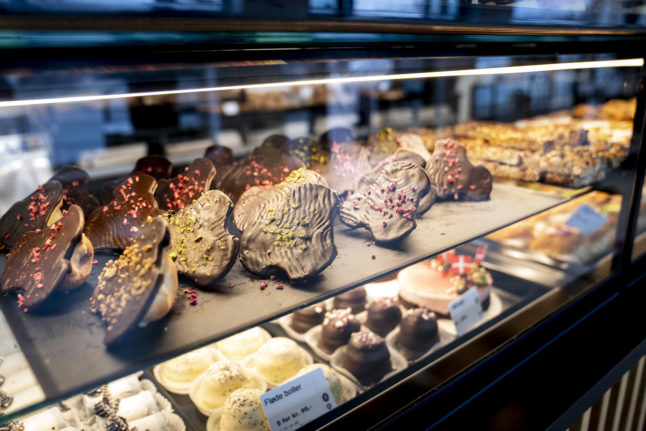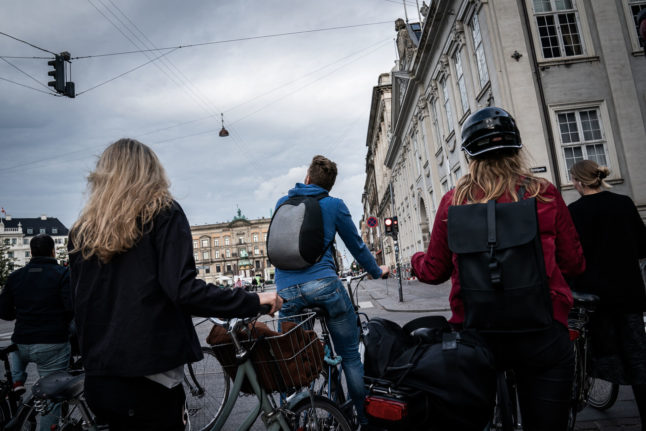Napoleonshat
Literally translating as “Napoleon’s hat”, this pastry, which consists of a ball of marzipan baked on top of a shortbread biscuit, folded in the shape of a tricorne hat and dipped in dark chocolate, dates all the way back to 1856.
In the early 19th century, Denmark sided with France in the Napoleonic wars, which proved to be a bad idea: the UK bombed Copenhagen, stole the Danes’ entire naval fleet and Denmark was forced to concede Norway to Sweden following the Treaty of Kiel in 1814.
At least the Danes got a pastry out of it: and the triangular marzipan-flavoured pastries – somewhere between a cake and a biscuit – are still popular in Denmark as a great afternoon treat with a cup of coffee.
A napoleonshat should not be confused with the equally delicious napoleonskage, which is a cake similar to a French mille–feuille, a dessert consisting of two layers of puff pastry filled with cream and raspberry jam and glazed with white or brown icing.
Kartoffelkage
Despite the name, you’ll be pleased to know that a kartoffelkage (literally: “potato cake”) does not include potatoes, with the cake instead getting its name due to its resemblance to a freshly-dug potato.
Kartoffelkager are a classic Danish cream cake or flødeskumskage, consisting of choux pastry (vandbakkelse) filled with crème pâtissière, known as kagecreme or “cake cream” in Danish.
They are then topped with a disc of marzipan and dusted with cocoa powder, giving them the appearance of a muddy potato fresh out of the ground.
Best eaten as fresh as possible and using a fork, it’s easy to understand how this cake, with the bitter cocoa powder, smooth vanilla-flavoured kagecreme and obligatory marzipan has become a classic.
Kajkage

From one classic to another, the kajkage is an essential Danish cake which you’re unlikely to find in hip Copenhagen bakeries.
This cake, shaped like a frog and covered in lime-green marzipan, is easier to find outside of Denmark’s larger cities, where you’re likely to see it in the shop windows of smaller local bakeries who aren’t too snobbish to stock the less-than-elegant pastry.
Originally referred to as a simple frøkage (frog cake), legend has it that an enterprising baker in Holstebro in western Jutland started marketing the cake under the name kajkage in the 1980s, after Kaj the frog, from popular children’s TV series Kaj og Andrea (Kaj and Andrea).
A kajkage consists of a macaron-style base, known as a mazarinbunde in Danish, where marzipan (yes, the Danes love marzipan if you haven’t already figured that out), is mixed with egg, flour, sugar and butter and baked into a thin cake.
This is then cut out into rounds and topped with a layer of raspberry jam, then a layer of buttercream, which is then covered in green marzipan. A slice is then cut into the marzipan for the frog’s mouth with an optional red marzipan tongue, and two googly eyes are piped on to finish the cake.
Understandably popular with children, you should try a kajkage at least once in your life – if only to impress any Danes you know from more rural areas of Denmark with your local cake knowledge.
Medaljer
Another classic, medaljer (medals) are the first cake on this list which do not include marzipan.
They have fallen somewhat out of fashion in recent years, but join kartoffelkager as one of the essential flødekager, which became popular at the turn of the 20th century when new technological advances made it possible to keep dairy products cold.
Medaljer, unlike kajkager, are extremely elegant, consisting of two discs of shortcrust pastry filled with a ring of either whipped cream or crème pâtissière, filled with some sort of compote or jam, usually a sour flavour to cut through the rich cream like raspberry or apple. They are then topped with icing or dark chocolate, and some sort of decoration, like a piped blob of cream or some fresh fruit.
Despite their often simple appearance, medaljer are surprisingly difficult to make, as the texture of the cream and compote filling must be stiff enough to ensure it can hold up the biscuit on top, while not being over-whipped.
Gåsebryst
The final cake on this list, invented in western Sjælland at the beginning of the 1900s, is a gåsebryst (goose breast).
It gets its name from the domed shape and texture of the white marzipan topping. When marzipan was still made and rolled-out by hand, it was difficult to get it completely smooth, with the texture ending up similar to the feathers on a goose’s breast.
A gåsebryst is a somewhat old-fashioned cake which you are more likely to find at a konditor than a standard bakery.
It consists of a base made of sponge cake or puff pastry, spread with some kind of fruit compote or jam (usually raspberry, more traditionally prune), and a dome of cream and kagecreme, formed into a long log. The log is then topped with uncoloured marzipan and drizzled with chocolate, then sliced into individual slices so the cross-section of the cake is visible.



 Please whitelist us to continue reading.
Please whitelist us to continue reading.
Member comments